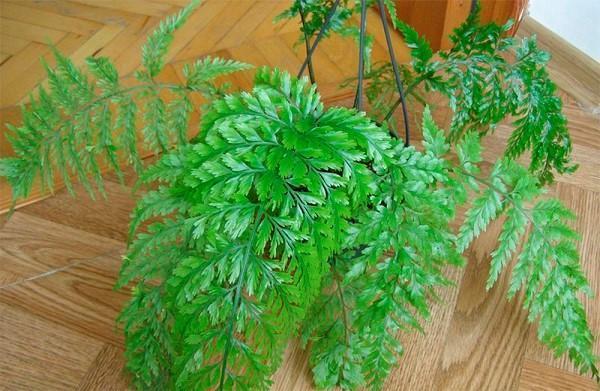Lush handsome asplenium onion-bearing
 According to various sources, the onion-bearing asplenium came to us from India, Australia and New Zealand. This type of fern can most often be found on indoor windowsills, but it also feels good in a winter garden or greenhouses, where the air temperature does not drop below 20 degrees Celsius.
According to various sources, the onion-bearing asplenium came to us from India, Australia and New Zealand. This type of fern can most often be found on indoor windowsills, but it also feels good in a winter garden or greenhouses, where the air temperature does not drop below 20 degrees Celsius.
Description of the variety
Asplenium onion-bearing are herbaceous deciduous ferns. It has very beautiful leaves, elongated in the shape of a triangle, three times pinnate and hanging down. The width of the leaf plate is almost half of its length - 30 and 60 cm, respectively. And the petiole itself is also quite long, up to 30 cm, straight, hard and dark green, while the feathers have a lighter shade.
The leaves of the asplenium onion-bearing bear a little resemblance to the tops of carrots, but unlike it, they shine with shine, and not matte.
Adventitious buds grow on the upper side of the leaf plate, and sporangia are located on the lower side of each lobe. Small bulbs form from the buds, and over time, children sprout from them. When the babies grow up, they separate from the mother leaf and fall to the ground, where they take root and form their own root system. Thus, you can get a lush bush or plant them in a separate bowl for fern propagation.
Growing features
In nature, Asplenium bulbiferous grows under the crowns of large trees or directly on rocks, in gorges.
In the wild, fern leaves are able to remain green until the very frost, but in the winter they fall off.
Indoors, the plant thrives in a confined potted space. Caring for him is not difficult and includes:
- Abundant watering... Like all fern varieties, the variety is very moisture-loving, so it is important not to let the soil in the pot dry out completely.
- Frequent spraying... The flower needs moist air and reacts well not only to spraying, but also to water procedures, for example, bathing in the shower.
- Periodic transplant... In principle, asplenium grows roots very slowly, but as a result of the shedding of children in a year, a bush that is too dense and dense in a pot is obtained. When transplanting, do not take too large a pot - you can leave the old flowerpot, but divide the fern so that it is not cramped.
If in the summer the plant is planted in open ground or simply put the pot outside, for the winter it must be taken indoors so that the leaves do not fall off and growth does not stop.